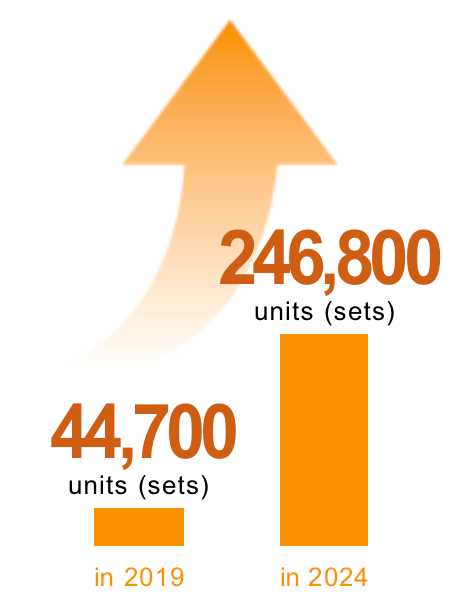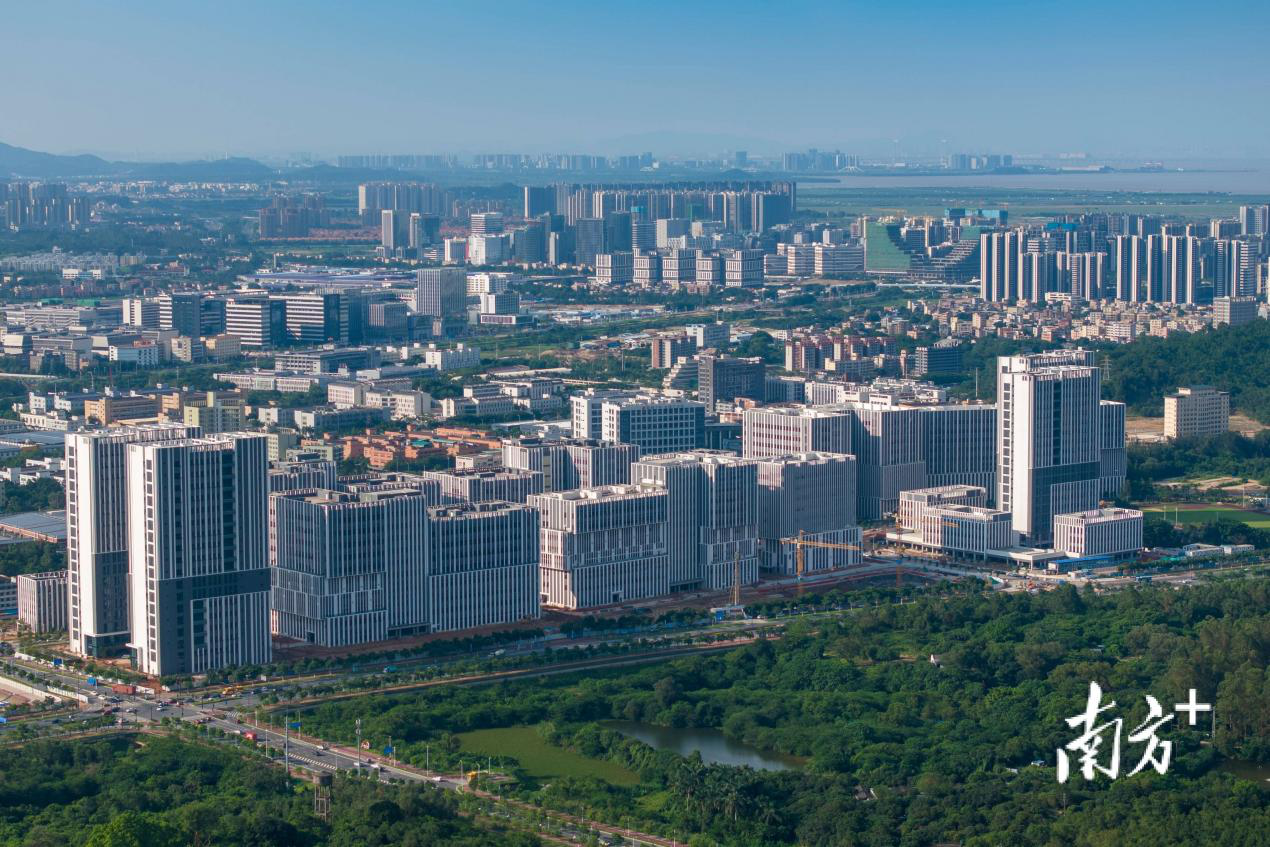In Guangdong, emerging industries such as AI and robotics, NEVs, biomedicine, and low-altitude economy have continuously achieved significant breakthroughs, forming a series of specialized industrial clusters with leading comprehensive strength. The rapid growth of Guangdong's cross-border e-commerce sector has significantly propelled the province's competitive industries into a new era of global expansion, akin to an "Age of Discovery".
AI + Robotics
Guangdong boasts the most comprehensive AI and robotics industry chain, the most advanced ecosystem, and the richest application scenarios in China. It also enjoys significant advantages in technological innovation, advanced manufacturing capabilities, and extensive market applications, providing a robust foundation and favorable conditions for the development of emerging and future industries.
Since 2018, Guangdong has consistently prioritized major projects under its provincial key R&D plan, including "New Generation Artificial Intelligence" and "Intelligent Robots and Equipment Manufacturing". To date, it has allocated nearly RMB 1.4 billion in provincial fiscal funds, leveraging an additional RMB 3 billion in social investments. Furthermore, Guangdong has coordinated these efforts with other critical initiatives, such as ICs design and manufacturing, industrial software development, brain science, and brain-inspired research, to accelerate the establishment of a multi-layered R&D system. These efforts have yielded notable results.
In 2024, the scale of core AI industries in Guangdong exceeded RMB 220 billion, firmly placing the province among the top-tier regions nationwide.

Pengcheng Laboratory developed China's first fully proprietary controllable E-level intelligent computing platform.
Guangming Laboratory established the nation's first research institute dedicated to the Ascend ecosystem.
The province is now home to over 1,500 core AI enterprises, with the number of national "Little Giant" enterprises specializing in AI ranking first in the country.
Industrial robot output increased from 44,700 units (sets) in 2019 to 246,800 units (sets) in 2024. Since 2020, Guangdong has maintained the top position nationwide for five consecutive years in this regard. Additionally, a comprehensive industrial chain covering "brain-sensory perception-mobility" for humanoid robots has been preliminarily established.

New Energy Vehicle (NEV)
Data released by the National Bureau of Statistics shows, in 2024, Guangdong produced 3.6178 million NEVs, accounting for one-quarter of the national total and maintaining its position as the top producer of NEVs in China. This means that one in every four NEVs manufactured nationwide comes from Guangdong. Guangdong's leadership in NEV production is attributed to its robust industrial foundation and a complete intelligent vehicle industrial chain. Currently, Guangdong has established a comprehensive industrial system for NEVs, with the supply chain achieving near self-sufficiency. The province boasts an over 80% self-sufficiency rate for critical components, forming a cluster of industries centered around Guangzhou and Shenzhen, complemented by cities such as Dongguan, Foshan, and Huizhou, and extending to eastern, western, and northern Guangdong.
Moreover, Guangdong's NEVs have successfully expanded into international markets, with NEV exports emerging as a key driver of the province's high-quality economic development.
Biomedicine
As the "first echelon" of China's biomedicine industry, Guangdong has established an early presence and achieved rapid development in related sectors. In 2024, the biomedicine and health industry cluster in Guangdong achieved operating income of about RMB 448.663 billion, while the pharmaceutical manufacturing sector reported an operating revenue of RMB 196.252 billion.
Guangdong has a solid foundation to grow the size and strength of its biomedicine industry. Data shows that the scale of the medical device industry in Guangdong has remained the largest in China for several consecutive years; Guangdong ranks first in the country in terms of the number of drug manufacturing licenses, traditional Chinese medicine manufacturing enterprises and medical device manufacturing enterprises. The production of products such as gene sequencers (accounting for over 40% of the national total) and ventilators (accounting for over 50% of the national total) ranks first in the country.
In 2024, four new P3 laboratories were built in Guangdong, bringing the number of high-level pathogenic microorganism laboratories in the province to 10, the highest in the country. Ten hospitals in the province rank among the top 100 according to the Science and Technology Evaluation Metrics (STEM) released by the Chinese Academy of Medical Sciences. Furthermore, Guangdong facilitates the Shenzhen-Hong Kong collaboration in establishing the Greater Bay Area International Clinical Trials Center. All cities in the province have achieved full coverage of one-stop direct settlement of basic medical insurance, critical illness insurance and medical assistance for local and inter-city medical treatment within the province. Shenzhen, Zhuhai, Zhongshan, and other cities have pioneered the inclusion of medical expenses associated with the Hong Kong and Macao Medicine and Equipment Connect program within the coverage of locally customized commercial health insurance, thereby addressing the differentiated healthcare security needs of residents.

Low-altitude Economy
As a strategically emerging industry in global competition, the low-altitude economy represents a critical direction for fostering and enhancing new quality productive forces. Guangdong accommodates over 30% of the nation's enterprises within the low-altitude economy industrial chain, showcasing a robust industrial agglomeration effect.
In terms of industrial chain integrity, Guangdong has established layouts across all segments of the UAV industry, encompassing raw materials, chips, components, power systems, and airborne equipment. It is one of the few regions capable of providing comprehensive local industrial chain support. From the perspective of technological innovation, Guangdong has made significant breakthroughs in key areas such as the development of electric vertical take-off and landing aircraft and the design of intelligent airspace management systems. The province is also home to globally recognized industry leaders like DJI and EHang, showcasing robust innovation capabilities.
In terms of market size, Guangdong's low-altitude economy exceeds RMB 100 billion. Consumer drones, led by DJI, command over 70% of the global market share, while industrial drones account for 50%.
From the perspective of technological innovation, Guangdong has made significant breakthroughs in key areas such as the development of electric vertical take-off and landing aircraft and the design of intelligent airspace management systems. The province is also home to globally recognized industry leaders like DJI and EHang, showcasing robust innovation capabilities.
In terms of the number of enterprises, Guangdong stands as the only province in the country boasting over 10,000 enterprises related to the low-altitude economy. Notably, Shenzhen and Guangzhou rank first and second nationwide, respectively, in terms of the number of low-altitude economy enterprises. Among those, Shenzhen's UAV industry accounts for 70% of the national output value, with a coverage rate of 65% of flight-suitable airspace. Additionally, Shenzhen has been approved to establish a national comprehensive demonstration zone for the low-altitude economy industry.

Cross-border E-commerce
Guangdong is the leading province in China's cross-border e-commerce sector, boasting the largest scale of cross-border e-commerce nationwide. The province is fully covered by comprehensive pilot zones for cross-border e-commerce, and it is home to over 200,000 enterprises operating in this field.
In 2024, Guangdong's cross-border e-commerce transaction volume reached RMB745.4 billion, accounting for more than one-third of the national total and over 10% of the province's foreign trade. All 21 prefecture-level cities in the province have been approved as comprehensive pilot zones for cross-border e-commerce. Guangzhou, Shenzhen and eastern Guangdong have become the three major growth poles for cross-border e-commerce. Global e-commerce platforms, including Amazon, Shein, and Alibaba International, have established regional headquarters in Guangdong. These platforms have fostered 15 listed cross-border e-commerce companies, such as Sailvan Times and Edayun.
Guangdong has implemented reforms to boost cross-border e-commerce innovation. Pearl River Delta cities are active in imports and exports, with significant exports to ASEAN, the United States, and the European Union. Development platforms have been upgraded to support enterprises going global.
Source | 2025 Invest Guangdong
Photo | Nanfang Daily
















